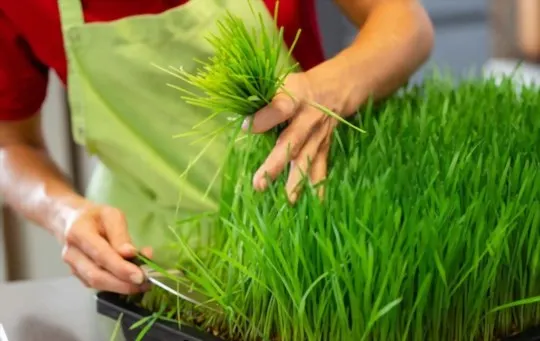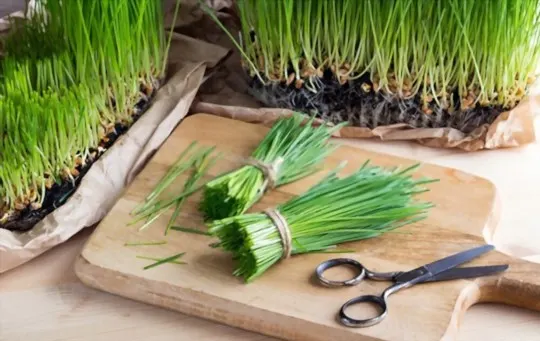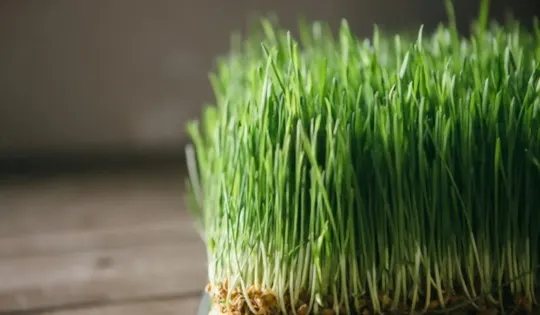Have you ever heard of wheatgrass and curious what does it taste like?
If so, then this comprehensive guide is for You!
Wheatgrass has become increasingly popular over the last few years because of its touted health benefits.
Whether you’re looking to include it in your diet or just want to know more about its flavor profile, we’ll give you all the details on what exactly wheatgrass tastes like.
Get ready to expand your palette as we uncover exactly how this superfood can fit into your life.
What is Wheatgrass?

Wheatgrass is a type of grass that belongs to the Triticum aestivum species, commonly known as wheat.
It is grown mainly for its nutritional value and used in the food industry.
Wheatgrass is an excellent source of vitamins and minerals, including vitamins A, C, E, and B complex, calcium, iron, magnesium, manganese, and selenium.
The young leaves of wheatgrass are harvested while still fresh and green to maintain their nutritional value.
They are then dried at low temperatures or pressed to make juice.
Wheatgrass juice is a popular health drink made by grinding young wheat plants into a liquid form.
It has become increasingly popular among health-conscious individuals due to its numerous health benefits.
Wheatgrass has long been known for its detoxifying properties.
It helps flush toxins from the body and improves digestion by promoting healthy bowel movements.
It is also known for boosting energy levels due to its high nutrient content.
Some studies have even suggested that wheatgrass may help prevent certain chronic diseases.
Overall, wheatgrass can be an excellent addition to a healthy diet due to its impressive nutritional profile and potential health benefits.
What Does Wheatgrass Taste Like?

Wheatgrass is a type of grass that is commonly used in health foods due to its nutrient-rich profile.
Many people wonder about the taste of wheatgrass, and whether or not it is palatable.
The taste of wheatgrass is often described as bitter and grassy.
Some people may find it unpleasant, but others enjoy the taste or simply tolerate it for its health benefits.
In terms of texture, wheatgrass has a fibrous and stringy consistency, which can make it difficult to blend or consume on its own.
This is why many people prefer to mix wheatgrass into juices or smoothies for a more pleasant drinking experience.
Despite the strong taste, there are many potential health benefits associated with consuming wheatgrass.
It is rich in vitamins, minerals, antioxidants, and chlorophyll, which can help boost immunity, detoxify the body, and reduce inflammation.
Overall, if you’re interested in trying wheatgrass for its nutritional benefits but are hesitant about the taste, consider incorporating it into a blended drink or finding recipes that combine it with other ingredients to improve the flavor.
How to Consume Wheatgrass?

To consume wheatgrass, there are a few methods that you can try.
One of the most popular ways to consume this healthy plant is by juicing it.
Wheatgrass juicers are available in many variations, including manual and electric models.
When it comes to juicing wheatgrass, it is essential to remember that you need a special extractor designed for this purpose.
A regular juicer won’t be able to handle the tough fibers found in wheatgrass plants.
After feeding the grass through the extractor, collect the juice in a cup and drink immediately.
Another way to consume wheatgrass is by adding it to smoothies or other drinks.
This method is preferred by those who don’t like the taste of pure wheatgrass juice but still want to reap its benefits.
Adding fresh or frozen fruit can help mask the taste of wheatgrass while providing additional nutrients.
In addition to juices and smoothies, you can also buy powdered wheatgrass supplements that can be added to water or other beverages.
This option is convenient for those who may not have access to fresh wheatgrass or don’t have time for juicing.
Overall, there are several different ways to consume wheatgrass depending on your preferences and needs.
Experimenting with different methods will help you find what works best for you.
1 – Juicing
Juicing is one of the most popular ways to consume wheatgrass.
Here are a few points that might come in handy if you’re planning on consuming wheatgrass through juicing:
- Wheatgrass can be juiced using a manual or an electric juicer. An electric juicer can help save time and effort.
- Wheatgrass juice should ideally be consumed within fifteen minutes of being juiced to retain maximum nutrients.
- For a more palatable taste, wheatgrass juice can be mixed with some fruit or vegetable juice. Beetroot and carrot juices pair well with wheatgrass.
- Depending on how much wheatgrass is used, the taste can vary from slightly sweet to bitter. It is best to start with smaller quantities and work your way up gradually.
- The ideal serving size for wheatgrass juice is 1-2 ounces per day.
If you’re new to consuming wheatgrass, it’s important to note that while the taste may not be everyone’s cup of tea, the benefits of consuming it are immense.
2 – Powdered form
Powdered form of wheatgrass is a convenient way to consume it without the hassle of juicing.
The process to make wheatgrass powder involves drying and grinding fresh wheatgrass into a fine powder.
This type of product is often sold in health stores and online shops.
Using powdered wheatgrass, you can simply add it to water or any beverage of your choice and drink it on the go.
The taste of wheatgrass powder is slightly earthy and bitter, which may not be appealing to everyone’s taste buds.
However, mixing it with sweet fruits, juices or smoothies can help mask the bitterness.
Apart from being easy to use, powdered wheatgrass also has a longer shelf life compared to fresh wheatgrass juice.
It also retains most of its nutritional benefits as it is made from freshly cut wheatgrass.
Consuming powdered wheatgrass provides numerous health benefits such as detoxifying the body, boosting the immune system, reducing inflammation and improving digestion.
Therefore, incorporating this superfood into your diet may prove to be beneficial for overall well-being.
3 – Capsules or tablets
Capsules or tablets are another popular form of wheatgrass that people consume.
These forms can be more convenient for those who don’t enjoy the taste of wheatgrass, as they don’t have to worry about the strong flavor.
Capsules and tablets also have a longer shelf life than powdered or freshly juiced wheatgrass.
Capsules and tablets are usually made by drying and grounding the wheatgrass into a fine powder, which is then compressed into a capsule or tablet form.
The recommended dose is typically one to three capsules/tablets per day, depending on the brand and concentration.
One advantage of capsules/tablets over powder or juice is that they make it easier to ensure you’re getting a consistent dose every time, instead of measuring out the correct amount each time you consume it.
They’re also portable and can be taken with you on-the-go.
However, some people may prefer fresh or powdered forms because they feel that the nutrient content in them is higher than what’s found in capsules/tablets.
Additionally, some brands of capsules/tablets may use fillers or other additives that aren’t present in fresh or powdered wheatgrass.
Benefits of Wheatgrass

Wheatgrass is a nutrient-dense, superfood that has several potential health benefits.
It is packed with vitamins, minerals, and antioxidants that can help improve digestion, boost immunity, and reduce inflammation in the body.
Here are a few benefits of consuming wheatgrass:
- Improved Digestion: Wheatgrass contains chlorophyll which helps flush out toxins from the body and promote healthy bowel movements.
- Boosts Immunity: Wheatgrass is rich in vitamins A, C, E and minerals such as zinc and magnesium which can help to strengthen your immune system.
- Reduces Inflammation: Wheatgrass contains anti-inflammatory compounds which can help to reduce inflammation in the body and alleviate symptoms of conditions such as arthritis.
- May Help Reduce Cholesterol Levels: Some studies suggest that consuming wheatgrass may help to lower LDL (bad) cholesterol levels in the body.
In addition to these benefits, consuming wheatgrass regularly may also help to improve skin health, aid weight loss efforts and increase energy levels.
Incorporating wheatgrass into your diet can be a great way to improve overall health.
It is important to note that while wheatgrass has numerous potential benefits for health, it may not be suitable for everyone.
Consult with a healthcare professional before incorporating wheatgrass into your diet if you have any underlying medical conditions or take any medications.
Risks and Precautions of Consuming Wheatgrass
Consuming wheatgrass has many benefits, but there are also risks and precautions that need to be taken.
One of the main risks is contamination from bacteria, which can cause illness or infection.
It is important to ensure that the wheatgrass is grown in clean conditions and properly handled during processing.
Another risk is allergic reaction.
Some people may have an allergic reaction to wheatgrass, particularly if they are also allergic to wheat or grass pollen.
Symptoms of an allergic reaction can include hives, swelling, and difficulty breathing.
If you suspect you are experiencing an allergic reaction after consuming wheatgrass, seek medical attention immediately.
It is also important to be aware of potential interactions with medications.
Wheatgrass may interact with some medications, including blood thinners and nonsteroidal anti-inflammatory drugs (NSAIDs).
If you are taking any medications, it is advisable to speak with your healthcare provider before adding wheatgrass to your diet.
Pregnant women should also exercise caution when consuming wheatgrass.
While there is limited research on the effects of consuming wheatgrass during pregnancy, some sources suggest that it may be harmful.
As a precaution, pregnant women should consult their healthcare provider before incorporating wheatgrass into their diet.
In addition to these risks, it is important to take precautions when consuming fresh or unpasteurized wheatgrass juice as it may contain harmful bacteria or toxins that can cause illness or infection.
Always ensure that the product has been properly processed and stored under sanitary conditions.
Why is Wheatgrass Bad for You?

Wheatgrass may not be advisable for some individuals due to several reasons.
- Consuming too much of it may cause nausea, vomiting and diarrhea. This can happen because wheatgrass contains high levels of chlorophyll that might not be easily digested by some people’s bodies.
- Wheatgrass can cause an allergic reaction in some individuals who are sensitive to certain grasses or pollens. An allergic reaction may manifest itself as hives, rashes or even anaphylactic shock.
- Wheatgrass is often sold and consumed raw which means it might contain harmful bacteria like E.coli and Salmonella. Contaminated wheatgrass can lead to food poisoning which can be severe and life-threatening in some cases. Therefore, it is important to source your wheatgrass from a credible vendor who follows strict quality control measures when growing and selling it.
- Wheatgrass is high in vitamin K which plays an essential role in blood clotting. Thus, if you are taking blood thinning medication like warfarin or aspirin you must be careful while consuming large quantities of wheatgrass as it could interfere with your medication and increase the bleeding risk.
Lastly, wheatgrass has a very strong taste that might deter some individuals from consuming it regularly.
It has been described as being grassy and bitter which could mean that blending it with other fruits or vegetables might make its consumption more palatable.
Conclusion
In summary, wheatgrass is a young grass of the wheat plant that is commonly consumed in the form of juice or powder.
It is known for its numerous health benefits due to its high nutrient content, including vitamins, minerals, and antioxidants.
Overall, while there are some potential drawbacks to consuming wheatgrass, it can be a beneficial addition to a balanced diet when consumed responsibly.
As with any new supplement or food product, it is best to consult with a healthcare professional before incorporating it into your routine.

What Does Wheatgrass Taste Like? A Comprehensive Guide
Ingredients
- Wheatgrass
- Ingredients from your selected recipes
Instructions
- Select ingredients that work well together.
- Use a recipe or method that will enhance their natural taste.
- Taste and adjust the recipe as needed to achieve the desired flavor.

Carrie is a food writer and editor with more than 15 years of experience. She has worked for some of the biggest names in the food industry, including Bon Appétit, Food & Wine, and Martha Stewart Living.
As the Editor in Chief of IntroChicago.com, Carrie oversees all of the content on the site. She also manages the team of contributing writers and editors, who help to create delicious recipes, helpful tips, and informative articles that you’ll find on the site.
A native of the Chicago area, Carrie is passionate about all things food. She loves trying new restaurants and experimenting with new recipes in her kitchen. She’s also a graduate of the Culinary Institute of America, so she knows a thing or two about food!
